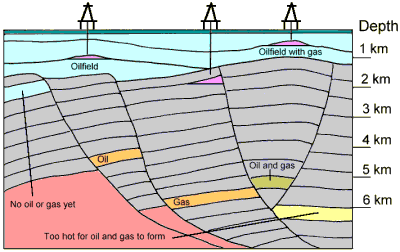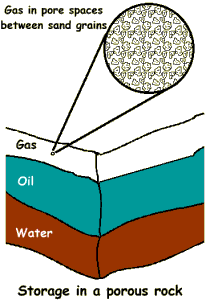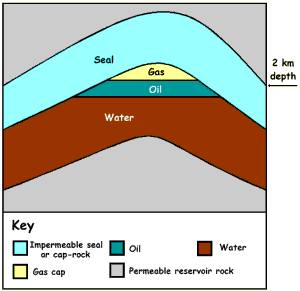
The right
conditions Britain has abundant
reserves of offshore oil and gas. These valuable fossil
fuels owe their existence to a precise sequence of
environmental conditions that occurred over millions of
years. First there had to be a source of suitable raw
material to create the oil and gas. Next, the environment
had to produce a suitable reservoir rock to store the oil
and gas, which tend to migrate upwards. And finally,
there had to be a rock seal, to prevent the fuel deposits
from escaping. Large deposits would only occur if a
suitable rock structure existed in the form of a trap.
 Click picture for full
page view
|
How are
oil and gas formed?

Almost all oil and gas is derived from tiny decayed
plants, algae and bacteria. Large quantities of this
material can accumulate in swampy environments or on the
seabed, where there is no oxygen to destroy the organic
matter. Gradually, more recent sediments settle on top,
burying the material deeper and deeper. As this happens,
both the temperature and pressure increase so that the
material is slowly cooked and altered, like food in a
pressure cooker. Energy first given to the plants by the
sun is then transferred into the useful form of oil or
gas, which contain chemicals called hydrocarbon compounds
-- that is hydrogen and carbon atoms joined together. Oil
forms first and then, as the temperature and pressure
continue to increase at greater depth, gas begins to
form. Loose sediments that harden into rock and contain
sufficient organic material to form oil are then called
source rocks.
Deep
heat
At depth, the buried algae, bacteria, spores and
cuticles (leaf skin) join their wax, fat and oil to form
dark specks called kerogen. Then, as the source rocks get
hotter, chains of hydrocarbon chemicals use this heat
energy to break away from the kerogen to form oil. At
greater depth, the temperature rises. At higher
temperatures the chains of hydrocarbon become shorter.
Short chains produce lighter oil, while long chains
produce heavier oil because of the lower temperatures.
Most of the oil under the North Sea was formed at great
depth and is therefore very light and of the highest
economic value. Beneath the North Sea, oil forms at a
depth of 3 - 4.5 km and gas at a depth of 4 - 6 km.
On the
move
Once formed, the oil and gas tend to migrate through
the rock that contains them. This movement occurs for two
reasons. First, the oil and gas expand to take up more
room than their source material of algae, bacteria and
leaf skins. Therefore their pressure on the rock
increases and they try to escape. Second, being less
dense than the surrounding rock and water, they tend to
rise upwards. This migration is a slow process, taking
millions of years for the oil and gas to rise a few
kilometres.
What
happens to the migrating oil and gas?
If there were no seal above the source rock, then the
oil and gas would slowly rise and escape at the surface.
Thus no hydrocarbon deposits would build up. This has
certainly happened on many occasions. However, geological
time spans millions of years, allowing new environments
to come into existence. For example, a desert could
develop whose sands could compact to form a layer of
sandstone over the source rock before any or all of the
oil and gas had formed or escaped. If this were the case,
then the migrating oil and gas could rise up into the
sandstone, which would act as a reservoir rock.
Reservoir
rocks

Sandstone can store oil and gas because it is both porous
and permeable. Porous means that liquids and gas can be
stored within the pores of the rock. Pores (the spaces
between all of the individual particles in the rock)
exist because the particles are irregularly shaped and
don't fit closely together. A permeable rock has pores
which are connected and allow oil or gas to flow through.
Of course, the oil and gas could eventually migrate all
the way through the sandstone layer too, so the deposits
will only remain in this reservoir of rock if another
layer forms on top which is impermeable i.e. does not
allow the liquids or gases to pass through and escape.
This impermeable layer is called a seal.

How a seal
forms -- one method
Over immense geological time a new sea could flood an
area of desert. Then salt from this sea could be
deposited to form an impermeable layer over the
sandstone, thus forming a seal which would trap the gas
and oil. The fossil fuels could accumulate in large
quantities if the powerful tectonic (geological) forces
in the Earth's crust pushed these sand and salt layers up
into a huge arch-shaped dome to create a vast trap.
Millions of years later on a cold and windy day, this oil
might eventually be released by a rapidly spinning drill
under the North Sea.
|

